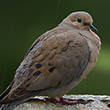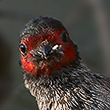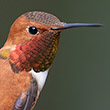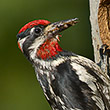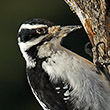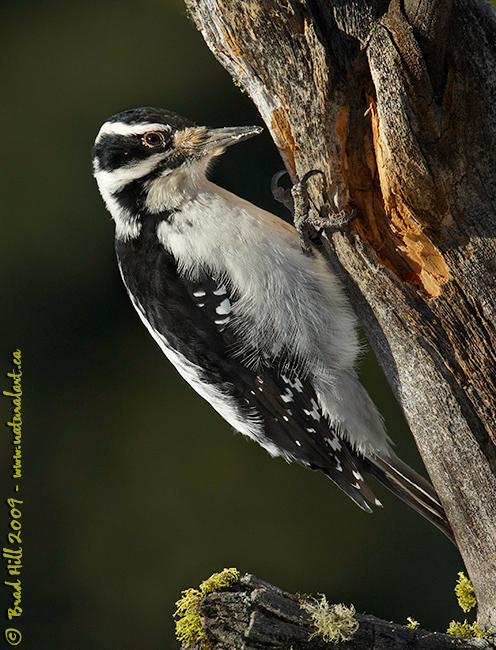
Availability: Undetermined - Enquiries?
In the Field
One Hairy Overhang... Findlay Creek, BC, Canada. January 13, 2009.
This female Hairy Woodpecker seemed almost impervious to gravity as it worked its way up this rotting (but very visually interesting) snag. The pose reminded me of some instances of humans "cliff-hanging" I've seen in movies featuring extreme sports. In this case the gravity-defying stance gave me a nice strong diagonal to work with - so my thanks are extended to the helpful woodpecker.
I like shooting subjects that challenge my image capture AND post-processing skills, and this is certainly a subject that does that! Getting close to a woodpecker in the right light is not that hard - but what is difficult is producing an image with good black-on-black detail AND good white-on-white detail. This woodpecker was strongly sidelit (sun to the left of the frame and low on the horizon) when I shot the image. In order to "open up" (lighten) the shadows a little, and to ensure that the black plumage had enough light on it to show detail, I had to add flash-fill to the subject. And, at the same time, to avoid "blowing-out" (over-exposing) the whitest portions of the bird, I had to UNDER-expose the image fairly dramatically compared to the "suggested" exposure of light meter (in matrix mode). While performing these two almost opposed actions (flash-fill and under-exposure) simultaneously seems almost counter-intuitive, it was necessary to do so to produce an image file that contained sufficient black-on-black detail and white-on-white detail to work on during post-processing.
The "trick" to processing this type of image is to find a way to work on and extract detail from both the whites and the blacks. One way is to use one of the many "Shadow/Highlight" tools found in most RAW converters OR in most quality image-editing software tools. My preferred method is to produce multiple 16-bit TIFF files from the original RAW file, each at a different exposure and/or Shadow/Highlight setting, and then combine (or composite) the images in Photoshop (using layering and masking techniques) to produce the final image. For example, with this image I made 3 raw conversions: 1 for the background and perch (at the exposure I thought was "right"), 1 to extract the black-on-black exposure, and 1 to get the white-on-white detail the way I wanted it. I then took all 3 exposure versions and took the "best of each" and combined them to produce the final image seen here.
Simple as pie - right? Well, perhaps a little more work than with your average "snapshot", but in my opinion, well worth the time and effort.
Behind the Camera
One Hairy Overhang... Findlay Creek, BC, Canada. January 13, 2009.
Digital Capture; Compressed RAW (NEF) 14-bit format; ISO 500.
Nikon D700 with AF-S Nikkor 600mm f/4G IF-ED II VR lens supported on Gitzo 1348 carbon fibre tripod with Wimberley head. VR turned to "On" and in "Tripod" mode. Autofocus set to M/a mode. SB-900 Flash mounted on Really Right Stuff Flash Bracket.
1/800s @ f11; -1.0 stop compensation from matrix-metered exposure setting. Flash fill using iTTL matrix balanced mode at -0.3 stops exposure compensation.
At the Computer
One Hairy Overhang... Findlay Creek, BC, Canada. January 13, 2009.
RAW Conversion to 16-bit TIFF, including first-pass/capture sharpening and shadow/highlight adjustments using Phase One's Capture One Pro 4.6.2. Three RAW conversions at different exposure settings: 0 stop compensation for highlight detail; +0.67 stops for background and perch; +0.67 adjustments plus shadow adjustment for black-on-black detail on woodpecker.
Further digital corrections on 16-bit TIFF file using Adobe's Photoshop CS4. Adjustments included compositing and masking of 3 exposure versions and selective sharpening for web output.
Conservation
One Hairy Overhang... Findlay Creek, BC, Canada. January 13, 2009.
Ten percent of the revenue generated by this image will be donated to Wildsight.
Species Status in Canada*: This species is not designated as at risk.
The Hairy Woodpecker (Picoides villosus) is widely distributed across North America and extends from Alaska and northern Canada south to the Yucatan. This species is one of the most geographically variable ones among all North American birds - it displays clinal variation in both size and colour across its range, with the more northerly birds being the largest and with the most white on them. The individual shown here was photographed in Canada and is the "larger and whiter" category. Despite being both common and widely distributed, there have been comparatively few detailed studies performed on the Hairy Woodpecker and much of its biology and behaviour remain poorly or incompletely understood.
This female Hairy Woodpecker was photographed in the Columbia Valley of the East Kootenays. While this species is not considered at risk in any way, many ecosystems within the Columbia Valley face development pressure. While Hairy Woodpeckers are not directly threatened in the Columbia Valley, they do, of course, need appropriate habitat in order to continue to thrive. Wildsight is an effective conservation organization that protects biodiversity and promotes sustainable communities in Canada's Columbia and Rocky Mountains. Support for Wildsight, through donation or becoming a member, will help ensure that they remain effective in their efforts to conserve threatened or endangered species and ecosystems.
*as determined by COSEWIC: The Committee on the Status of Endangered Wildlife in Canada



















